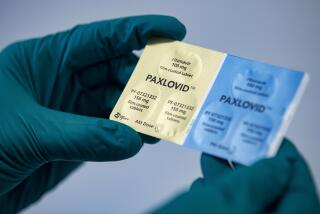Mixing Medications: Danger to the Elderly
- Share via
The statistics are startling: 11% of America’s population take one-third of the nation’s prescription medications and slightly more than one-half of all non-prescription drugs.
That 11% of the population are the elderly, those over 65, and for them the matter of medications--and the mixing of them--is one of concern on the part of health care experts.
One step to a solution of the problem is education--informing people, especially the elderly who take multiple medications for multiple problems, about the dangers of mixing medications, including the non-prescription drugs increasingly sold on an over-the-counter basis.
To that end, a new program was introduced last week at the National Council on the Aging annual meeting in San Francisco. It involves a learning kit, “Let’s Take ALL Our Medications Seriously,” to be used by senior centers and other group programs to inform older consumers about managing medications safely and effectively.
Peter Lamy Ph.D., director of the Center for the Study of Pharmacy and Therapeutics for the Elderly at the University of Maryland, Baltimore, is spokesman for the program underwritten by the McNeil Consumer Products Co. He attributed the program to three developments.
“The first is the increasing number of the elderly,” he said. “The second is the increasing activity by the Food and Drug Administration to put more and more prescription drugs on a non-prescription basis for over-the-counter sale.
Attention to Fitness
“In addition we have the ‘wellness’ thing, an attention to fitness and health in which people are buying more non-prescription drugs.”
Lamy, noting that “the elderly do not handle drugs as well as young people,” said that older people have more physical problems for each of which they may take multiple medications.
“A lot of medications may be very safe individually but not when taken with other drugs, prescription or non-prescription,” he said.
“We also need to test drugs on the elderly. There is a 1983 British study that said drugs ought to be tested in the elderly and for the specific problem for which the medications are being taken. We also need to test them with drugs taken along with other medications.
“We also need to study them over a period of time. What we may prescribe in younger people for three months, a person who is 85 may have taken for 10 years.”
While ingredients of medications generally are listed on the label, reading and understanding the label and what it signifies is “very difficult” for the average person, Lamy said.
And how do we educate people?
“Slowly,” Lamy said, adding that the 1981 White House conference on the elderly identified the problem of managing medications as a key problem. “This program is one of the responses to the findings of the conference that we need to educate people.”
Lamy said that laxatives, analgesics and antacids are often “overused” and that the learning kit includes a booklet in which people can list the medications they are taking so that their doctors and pharmacists can check them for interactions.
“We need to communicate,” he said. “We need to ask questions every time we get a medication. Sometimes we forget how we are to use things that have been prescribed.
“We need informed consumers.”
In addition to the personal health record book, the “Let’s Take ALL Our Medications Seriously” kit includes printed materials, a slide-tape presentation and information on specific categories of medications.
Information on local senior centers utilizing the educational program is available from Shirley Stadtmueller, Burson-Marsteller, 866 Third Ave., New York, N.Y. 10022, telephone (212) 752-8610.





